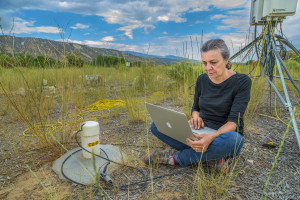
Jillian Banfield, Ph.D., UC Berkeley Professor and Berkeley Lab Earth Sciences Division staff scientist
Jillian Banfield, PhD is a prominent geomicrobiologist and biochemist, a UC Berkeley Professor, a Berkeley Lab Earth Sciences Division staff scientist, and a long time user of the DOE Joint Genome Institute’s resources through the Community Science Program (CSP) and the Emerging Technologies Opportunities Program (ETOP).
In this short interview, Jill shares her perspective how the DOE JGI helps advance her research addressing knowledge gaps related to the roles of subsurface microbial communities in biogeochemical cycling. Given the link between the carbon cycle and global climate change, a particular interest in this work is the impact of microorganisms on carbon compounds buried in the terrestrial subsurface, both through respiration and carbon fixation.
Near the town of Rifle, Colorado, lies the primary field site for Phase I of the Subsurface Systems Scientific Focus Area 2.0 (SFA 2.0, sponsored by the DOE Office of Biological and Environmental Research–BER). The site’s history as a milling facility for ores rich in uranium and other metals (such as vanadium, selenium, and arsenic) has resulted in low but persistent levels of contamination within subsurface sediments and groundwater. With the support of BER, Earth Sciences Division and their collaborators from the DOE Joint Genome Institute have conducted major investigations at the Rifle site, to facilitate integrated, field-based subsurface biogeochemical and microbial genomics research relevant to uranium mobility to improve the predictive understanding of subsurface flow and transport relevant to metal and radionuclide contaminants. Jill is shown here collecting data at the Rifle site.
How long have you collaborated with the JGI?
Since ~2000, about 15 years.
Which projects have you led that involved accessing the resources of JGI?
To name just a few:
- Acid mine drainage research (click here for the JGI news release):
- Subsurface biogeochemical cycling in the Rifle aquifer:
- Soil and vadose zone research at the Angelo Reserve in Northern California:
- Crystal Geyser – a deep subsurface CO2-saturated aquifer:
- Assembly and binning of microbial community metagenomic data supported through an ETOP project:
Why is this research important to advancing science and for the public good?
Microorganisms mediate critical biogeochemical cycles, yet their identities, roles and distributions remain largely unknown.
What do you value about JGI’s contribution?
High throughput sequencing required to generate the massive datasets and the opportunity to interact with staff on metagenomics methods.